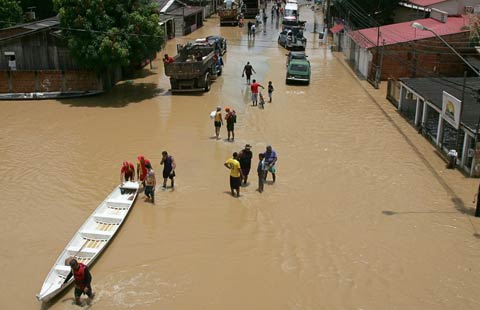Flooding risk inland: researchers
Updated: 2015-03-05 11:42
By Amy He in New York(China Daily USA)
|
|||||||||
China has the third-highest population in the world at risk of inland flooding due to climate change, according to new analysis from Washington-based World Resources Institute.
The environmental research institute said on Thursday that out of 160 countries analyzed, China ranks only behind India and Bangladesh, with approximately 3.2 million of its people being affected by inland flooding every year.
"We project future flood risk forward to the year 2030, and by looking at that, you can tell that you can tell frequency and intensity of flood events are increasing due to climate change, primarily," said Tianyi Luo, research analyst in the World Resources Institute's (WRI) water program. "Much of the country is expected to see much greater exposure to flood risks."
The top five provinces in China affected by river flooding are Jiangsu, Guangdong, Henan, Anhui and Hebei. River size can contribute to the frequency of floods, as does rainfall and general geography, Luo said.
The south gets more rainfall than the north, and depending on topography, where people live - whether in a flood-prone area or not - rainfall can affect the potential for inland flooding, he said.
Annual flooding is affecting $22.3 billion of China's current GDP, and by 2030, it's expected to affect $120 billion, according to WRI estimates. By 2030, close to 5 million people could be affected by flooding, compared with the 3.2 million now.
A Feb 24 report from the UN Economic and Social Commission for Asia and the Pacific said that floods caused the most fatalities in the Asia-Pacific region in 2014, as well as the most economic losses.
The report called the increase of floods an "indication of an emerging trend" that required a regional cooperation system throughout the Asia-Pacific region, which sees much of the world's flood disasters.
There are three major kinds of floods in China, according to Luo: river floods, flash floods and storm surges. River floods happen when there is continuous rainfall for long periods, causing inland flooding; flash floods occur when there is intensive rainfall in cities, which may or may not be equipped with the types of drainage systems to handle the rainfall. Storm surges take place along coastal lines that are near large bodies of water.
The WRI's analysis is part of a new online tool that helps academics and professionals track floods across the world and assess them according to potential GDP damage, urban damage and population risk. The Flood Analyzer's data will be available to the public free of charge, geared toward disaster risk-reduction monitoring organizations, international financing organizations like the World Bank, and insurance companies that might not have in-house modeling techniques.
According to an October report from the Chinese National Disaster Reduction Office and Ministry of Civil Affairs, more than 700 people were killed as a result of floods. More than 3.5 million people were forced to evacuate their homes, and 249,000 houses were destroyed.
Luo said that the government could invest in risk-reduction projects, which includes building green or gray infrastructure for better storm-water management. Gray infrastructure refers to traditional treatment systems, such as pipes and sewers, and green infrastructure refers to using environmentally friendly techniques to treat storm water.
"After a certain point, building infrastructure is no longer cost-efficient," Luo said. "Then the government might want to consider insurance. China right now doesn't have mandatory insurance requirements for people or assets in flood-prone areas, unlike the US."
amyhe@chinadailyusa.com

 Across Canada March 4
Across Canada March 4
 Seven things you may not know about Lantern Festival
Seven things you may not know about Lantern Festival
 Top 10 destinations for Chinese tourists
Top 10 destinations for Chinese tourists
 Floods displace over 2,000 in Brazil
Floods displace over 2,000 in Brazil
 New sports cars debut Geneva motor show
New sports cars debut Geneva motor show
 People celebrate upcoming Lantern Festival across China
People celebrate upcoming Lantern Festival across China
 Chinese investors take bite of Big Apple
Chinese investors take bite of Big Apple
 Intl Hair Freezing Contest winners announced
Intl Hair Freezing Contest winners announced
Most Viewed
Editor's Picks

|

|

|

|

|

|
Today's Top News
US fails to grasp China's terror laws: legislature
Militaries' cooperation 'key' in ties
China, California address climate, energy issues
US companies bullish on China
China faces 'formidable challenges', says Li
Diplomats talk about 'two sessions'
GDP target drops to 7%
US ambassador to S.Korea attacked
US Weekly

|

|








